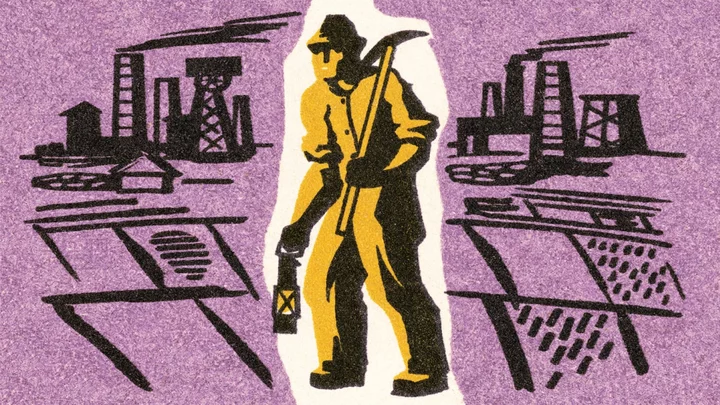In the summer of 2019, coal workers in Harlan County, Kentucky, staged a two-month-long railroad blockade to force bankrupt coal company Blackjewel to pay them what they were owed. (It worked.) One sign encapsulated the moral crux of this—and every—labor dispute in one pithy question: “Which Side Are You On?”
It was a nod to the strikers’ anthem of the same name, popularized by Pete Seeger in the 1940s. But to see or hear the words referenced in Harlan County is especially significant—because that’s where Florence Reece wrote the song in 1931, while her husband and his fellow coal miners waged one of the most infamous labor wars in U.S. history.
- They Say in Harlan County, There Are No Neutrals There
- Will You Be a Lousy Scab, or Will You Be a Man?
- My Daddy Was a Miner
- Come, All You Poor Workers
- ’Til Every Battle’s Won
They Say in Harlan County, There Are No Neutrals There
Harlan County, Kentucky, an insular, mountainous patch of land right along the Virginia border, welcomed its first railroad in 1910. With it came the coal barons.
By the late 1920s, coal hadn’t just supplanted agriculture as Harlan’s economic bedrock—it had completely taken over society. Mine owners hijacked local governments and used workers’ wages to help finance new schools and churches. They forced miners to rent housing in company-established camps, where “coal operators” oversaw virtually every aspect of life; in some camps, workers even had to buy all their goods at the company store. Rules were enforced by “deputy sheriffs,” who, though appointed by local officials—themselves typically in the pocket of the mine owners—were on the company payroll.
This authoritarianism enabled the coal operators to keep miners from unionizing: Anyone who tried was simply kicked out. As a result, Harlan County miners were paid significantly less than their unionized peers for doing significantly more labor. In 1922, for example, a day’s work in an Illinois mine would net you 42 percent more money than it would in Harlan County. Part of the problem was that the bosses were known to short-weigh the coal loads so they could short-change the laborers, who also weren’t paid at all for the several hours of clean-up required after a loading shift.
Harlan County’s workforce suffered these injustices mostly in silence until the Great Depression devastated business to the point of threatening their very lives. Steady work became scarce, wages fell, and malnourished children started dying by the dozen. When wage rates were slashed another 10 percent on February 16, 1931, the miners decided they had no choice but to unionize, no matter the cost.
Will You Be a Lousy Scab, or Will You Be a Man?
Representatives from the United Mine Workers of America (UMWA) held gatherings that were crawling with corporate moles, who made certain newly enlisted union members were both fired and evicted. Many displaced workers relocated to Evarts, one of the few Harlan County towns uncontrolled by mine owners. Though an official strike hadn’t been declared, the atmosphere mirrored one: Any miner was more or less refusing to work by joining the union, and those hired in their stead were considered scabs.
The unionizers had a powerful enemy in Harlan County sheriff John Henry Blair, whose squads of deputy sheriffs—nicknamed “gun thugs” by their opponents—featured many former criminals who didn’t hesitate to use violence in their pursuits; namely, evicting union men and guarding their non-union counterparts. The union side fought fire with fire, looting company stores and local businesses, burning down camp houses, and firing their weapons with reckless abandon.
The conflict came to a head on May 5 in what’s known as the Battle of Evarts. Union miners ambushed a truck transporting supplies to non-union miners, resulting in a shoot-out that left four men dead and fueled a wave of chaos across town. “For two days a virtual state of anarchy reigned in Evarts. The public schools closed, and a number of families fled the county,” John Hevener wrote in his 1978 book Which Side Are You On?.
The National Guard was summoned to quell the uprising, and a more organized strike began in earnest. But the out-of-work miners soon faced a starvation crisis. The cash-strapped UMWA couldn’t offer aid; the Red Cross and National Guard both refused to provide for people who were choosing not to work.
It was in the midst of all this strife that Florence Reece pulled her calendar off the wall and on it scrawled the lyrics that would echo across working-class crusades for generations to come.
My Daddy Was a Miner
In April 1900, Florence Reece was born in Sharps Chapel, Tennessee, to a coal-mining father and a mother who filled the house with hymns. “From the time I was born there was always singing,” Reece told Mountain Life & Work in 1971. “When I was little, my brothers would ask me to preach and sing over a dead chicken or whatever. So I would compose my song over the dead dog or a chicken and then they began to call me preacher.”
Reece’s father died in the mines when she was about 14 years old; not long after, she married Sam Reece, who was also a coal miner. Sam was around 19 years old at the time, and had been working since early adolescence. “Sixty cents a day. And there wasn’t no such thing as hours. He’d come out of there way in the dark of the night. And him just a little boy,” Reece said in an interview for Kathy Kahn’s 1973 book Hillbilly Women.
The couple settled in Harlan County in 1922 after being forced out of Fork Ridge, Tennessee, over Sam’s union ties. When he wasn’t helping unionize his fellow miners during the 1931 strike, Reece’s husband was on the run from Blair’s lackeys.
“The thugs made my mind up for me right off, which side I was on,” she said. “They would come to our house in four and five carloads and they all had guns and belts around them filled with cartridges.” In addition to hunting for her husband, they often raided the place for weapons and any literature that could link the Reeces to the Communist Party or Industrial Workers of the World, a more radical labor union.
Reece recalled one especially tense visit in which a raider started to crank a record player that was harboring Sam’s shotgun shells: “I said, ‘You can’t play that. It’s broke.’ … And he stopped cranking it. I knowed if they’d started a-playin’ it they’d’ve killed every one of us.”
Come, All You Poor Workers
One night while Sam was on the lam, Reece caught word that the deputies were planning to arrest either her or her teenaged son Harvey—one of seven Reece kids—until Sam turned himself in. She told Harvey to flee and then, moved to communicate the plight of her own family and the rest of Harlan County’s strikers, penned the lyrics to “Which Side Are You On?” on the wall calendar—the only paper available. “We couldn’t get word out any way. So I just had to do something,” she said.
Reece wrote “Which Side Are You On?” to the tune of an existing song, though it’s not totally clear which one. She told Mountain Life & Work that it was an old hymn called “I’m Going to Land on That Shore,” but folk singer Oscar Brand remembered her telling him it was a variation of the old Scottish folk song “Jackie Munro.”
The lyrical discrepancies across different versions of “Which Side Are You On?” reflect the oral nature of that genre: e.g. “Come all you poor workers” versus “Come all of you good workers,” and “Will you be a gun thug?” versus “Will you be a lousy scab?” What remains consistent is the song’s essence as a reminder to all workers that they, by default of being workers, are on the same side—so siding with “The Man” during a labor dispute is essentially class betrayal.
Reece’s labor anthem didn’t immediately gain fame. By her own account, she’d sing it “for neighbors mainly, not crowds.” And the strike itself proved short-lived, in part because officials conducted a successful smear campaign to discredit the UMWA as radical and banned its members from holding meetings. The strikers realized the only way to feed their starving families was to head back to the mines—and by mid-June, the bulk of them had.
But it wasn’t the end of Harlan County’s movement to unionize. The 1931 strike kicked off a series of similar clashes that lasted for nearly the whole decade. Federal investigations into abuses of power and new labor laws eventually put a stop to what’s now known as the “Harlan County War” or “Bloody Harlan.”
’Til Every Battle’s Won
Nor, of course, was it the end of “Which Side Are You On?,” thanks in part to one of Sam’s fellow union organizers, Tillman Cadle. While in New York City for shoulder surgery in the mid-1930s, Cadle met his future wife: folklorist Mary Elizabeth Barnicle. The two spent the next 15 years or so collecting folk songs in the South, including Reece’s Harlan County ballad. Cadle brought it to Pete Seeger, then an up-and-comer in New York’s folk music scene.
“I’ve got a new song for you Pete,” Cadle recalled telling him. “I believe it’ll make a hit if you’ll sing it.” With the Reeces’ permission, Seeger recorded the track with his band, the Almanac Singers, and released it on their 1941 album Talking Union.
Since then, “Which Side Are You On?” has become a multi-purpose anthem for any fight against oppression. In 2015, Talib Kweli and 9th Wonder released a remix to recognize the 20th National Day of Protest to Stop Police Brutality; and Megan Slankard and Lia Rose collaborated on another remix for Bernie Sanders’s 2020 presidential campaign. Seeger’s version was even featured—rather ironically—in an episode of HBO’s Succession.
The Reeces eventually returned to Tennessee, where Sam died in 1978 from coal workers’ pneumoconiosis, or “black lung.” Reece passed away eight years later at age 86 after a heart attack. Her own rendition of “Which Side Are You On?” is immortalized in Barbara Kopple’s 1976 Oscar-winning documentary Harlan County, USA, which chronicles another Harlan County coal miners’ strike in 1973. In the film, Reece offers support and sympathy to an audience of UMWA strikers before performing the song a cappella.
“You can ask the scabs and the gun thugs which side they’re on—because they’re workers, too,” she tells the crowd.
Related Tags
History MUSIC WORK CULTURE MUSIC HISTORY Pop Culture WORDS BUSINESS MONEY WAR Home / HISTORY








